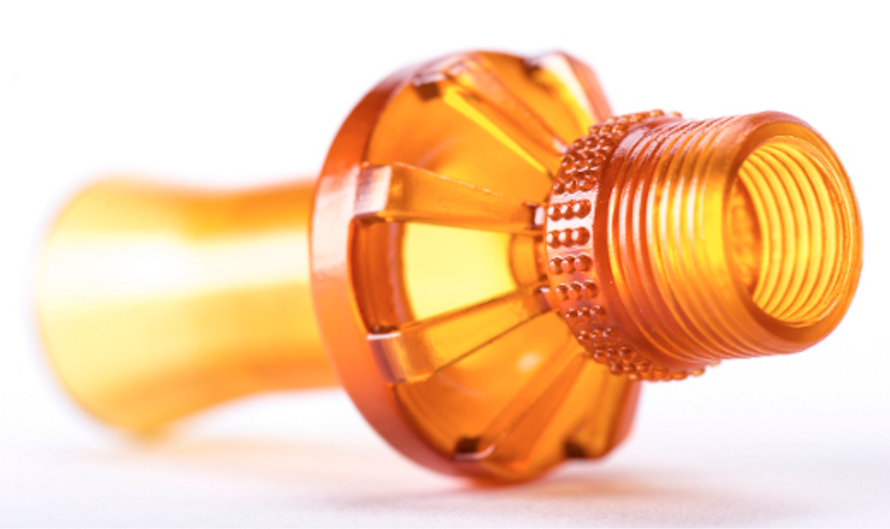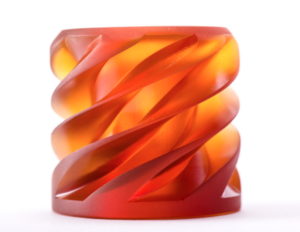 When 3D printing startup Carbon released the first video of of their CLIP 3D printing technology in action it was almost unbelievable. Watching a solid, three dimensional model be pulled from a pool of liquid resin in a matter of minutes seemed almost like a trick, and I remember more than a few suggestions at the time that it was. But a year later and no one is questioning how real CLIP technology is anymore; now they’re lining up to get their hands on it. Carbon has already released the M1, their first printer to feature CLIP, and they’ve partnered with some high profile companies to put their technology through its paces.
When 3D printing startup Carbon released the first video of of their CLIP 3D printing technology in action it was almost unbelievable. Watching a solid, three dimensional model be pulled from a pool of liquid resin in a matter of minutes seemed almost like a trick, and I remember more than a few suggestions at the time that it was. But a year later and no one is questioning how real CLIP technology is anymore; now they’re lining up to get their hands on it. Carbon has already released the M1, their first printer to feature CLIP, and they’ve partnered with some high profile companies to put their technology through its paces.
 One of the first companies that got their hands on a Carbon M1 DLP 3D printer was global 3D printing services provider Sculpteo, which has been posting updates about their ongoing testing on their blog. A few months back Sculpteo gave us a rundown of the versatile resins that they were testing on the M1, and they will be taking a closer look at each of those materials throughout their testing process. A few weeks back they posted about Rigid Polyurethane resin, a material that has a similar finish and properties of an injection molded part. And they just released a new blog post detailing their experiences with Cyanate Ester (CE), a material that has high-performance and heat-resistant properties.
One of the first companies that got their hands on a Carbon M1 DLP 3D printer was global 3D printing services provider Sculpteo, which has been posting updates about their ongoing testing on their blog. A few months back Sculpteo gave us a rundown of the versatile resins that they were testing on the M1, and they will be taking a closer look at each of those materials throughout their testing process. A few weeks back they posted about Rigid Polyurethane resin, a material that has a similar finish and properties of an injection molded part. And they just released a new blog post detailing their experiences with Cyanate Ester (CE), a material that has high-performance and heat-resistant properties.
Cyanate Ester resin is probably one of the more interesting resin materials that will be available for the M1. While there have been several high-performance resins available, CE seems to bring end-use functionality that can be manufactured in a matter of minutes to the table. The translucent amber finish will have a smooth and shiny surface finish right out of the printer and will actually become dull and matte when polished. Finished parts will be extremely strong and stiff and capable of deflecting heat up to an impressive 219°C (426°F). The long term thermal stability of CE makes it an ideal material for automotive applications, electronics and industrial parts that need to survive and continue to perform in hot environments.
Here is some video of Cyanate Ester resisting high temperatures in a forced circulation heated oven compared to an acrylate resin typically used for prototyping:
Sculpteo notes that while CE is quite rigid and capable of extremely precise high resolution parts as thin as 0.25 mm, they’re not ready to offer interlocking or moving parts just yet. Although the material is certainly strong enough, as with all of the CLIP resins, the parts will typically need supports that will have to be removed. Depending on the geometry of the 3D model, those supports could be difficult to remove. Testing out new materials is a time consuming process, so it’s just too early for them to know if it’s possible, what the minimum clearance would be or what the best method of printing and adding easily removable supports would be.
 Carbon’s CLIP (Continuous Liquid Interface Production) technology is the fastest of the stereolithography 3D printing methods on the market, and most parts need very little post processing. However, parts made with Cyanate Ester will need to undergo a secondary curing stage in order to unlock its advanced engineering properties. In order to overcome the typically brittle finished parts usually associated with photopolymerized parts, Carbon has embedded a second heat-activated reactive material that causes the part to become significantly stronger and durable. Once the printed CE part has undergone this secondary process, it will take on its high-performance engineering-grade mechanical properties.
Carbon’s CLIP (Continuous Liquid Interface Production) technology is the fastest of the stereolithography 3D printing methods on the market, and most parts need very little post processing. However, parts made with Cyanate Ester will need to undergo a secondary curing stage in order to unlock its advanced engineering properties. In order to overcome the typically brittle finished parts usually associated with photopolymerized parts, Carbon has embedded a second heat-activated reactive material that causes the part to become significantly stronger and durable. Once the printed CE part has undergone this secondary process, it will take on its high-performance engineering-grade mechanical properties.
Several of Sculpteo’s automotive and aerospace clients are already using CE for tooling or mechanical parts and so far the results have been promising. While it is still quite early, it seems that Carbon and their CLIP technology are going to be a hit, and likely one of the first real contenders to bring DLP 3D printing to more industries and applications than ever before. If you would like to try out the technology then you can register for Sculpteo’s CLIP Pilot Program and give it a try. Sculpteo offers two types of finishes: the raw finish which is left as is and only has the supports removed, or hand polished, which smooths the surfaces and removes any scarring left over from the supports. You can read the entire blog post detailing their work with Cyanate Ester here. Is this a material you are interested in working with? Discuss further over in the New Cyanate Ester 3D Printing Resin forum at 3DPB.com.
Subscribe to Our Email Newsletter
Stay up-to-date on all the latest news from the 3D printing industry and receive information and offers from third party vendors.
You May Also Like
HILOS Launches Studio OS for AI-Driven 3D Printed Shoe Design
At Milan Design Week, footwear 3D printing startup HILOS has unveiled its latest development, Studio OS. Introduced at the historical Villa Bagatti Valsecchi, the platform is meant to redefine how...
3D Printing Webinar and Event Roundup: April 28, 2024
In this week’s 3D Printing Webinar and Event Roundup, the Ceramics Expo is taking place in Michigan, Stratasys continues its advanced training courses, and SPE is holding a Polymer Characterization...
Initial Speakers and Sponsors Announced for Additive Manufacturing Strategies 2025
Nearly a year away from the event, the Additive Manufacturing Strategies (AMS) 2025 conference is already beginning to take shape. Building upon the success of 2024’s summit, AMS has established...
HP & INDO-MIM Collaborate to Boost Metal 3D Printing in India
HP Inc. and INDO-MIM, a US- and India-based supplier of metal injection molding (MIM) powders and contract manufacturer, have announced that the two companies will collaborate to accelerate additive manufacturing...































